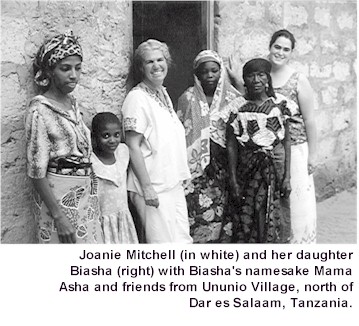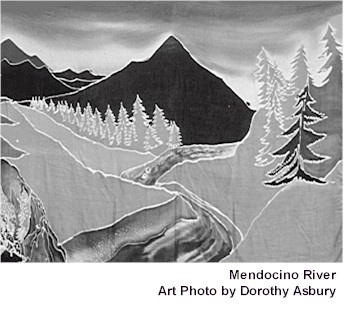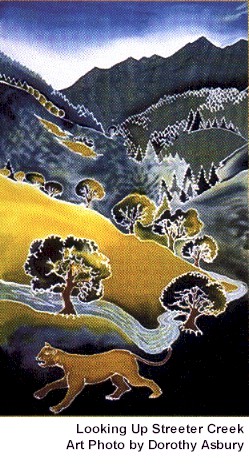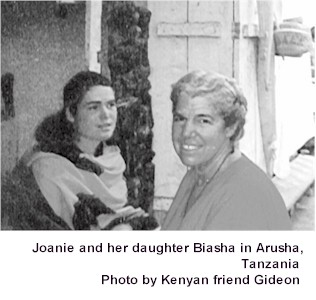I
started drawing when I was really young and later showed a facility for
capturing gestures with a Rapidograph drafting pen. When I was a
senior in high school, I went to the local art academy in the afternoons
to take life-drawing classes. After that, I had to make a decision whether
to attend art school or college. I was accepted at Cooper Union, a free
art school in New York, but there was no housing there. I was just a girl
from Cincinnati--unprepared to be on my own in New York--so I went to Sarah
Lawrence College instead. I didn't do much art, but did spend my junior
year at Columbia University, living in Harlem and attending a life-drawing
class at Columbia General Studies. This was my most meaningful art experience
since high school. I graduated in 1963, and went on to graduate school
in Cincinnati to become a community planner.
I still have drawings from when I was
in college and thereafter. My art is what I see. I have always found the
external world endlessly stimulating; in New York and later in my travels
I carried a sketchbook everywhere. It wasn't so much a discipline as that
I had to keep drawing. I would see the faces of people, and I would have
to capture them.
My master's degree allowed me to have many
rich experiences and to work in other countries. In 1968 I went to London
where I attended the London School of Economics for a year. Student demonstrations
were going on at that time all over Europe. When the students in Paris
were protesting the government of Charles De Gaulle, I flew to Paris without
knowing French, and spent an adventurous and amazing week there.
London was also having demonstrations against
the Vietnam War. At a student demonstration, I noticed an elderly artist
drawing in the huge school auditorium. I recognized his drawing style and
asked him whether he could possibly be Felix Topolski. (My mom, a librarian,
liked his art when I was young, and we had collected his books.) He was.
He invited me to come to his studio and bring some of my work. He told
me to dare--to be as daring as I possibly could. If there was something
I wanted to do, he said, I should do it.

 Shortly
after that, the school year was coming to an end. At a party somebody handed
me a flyer about flights to Africa. I had been in a course with students
from all over the Third World who gave talks about their country, and when
the students from Zambia spoke I was drawn to this place in Africa. I decided
to go there, but Zambia turned out to be the one place in Africa I never
visited. I ended up booking a one-way ticket to Nairobi, Kenya without
even knowing which side of the continent it was on.
Shortly
after that, the school year was coming to an end. At a party somebody handed
me a flyer about flights to Africa. I had been in a course with students
from all over the Third World who gave talks about their country, and when
the students from Zambia spoke I was drawn to this place in Africa. I decided
to go there, but Zambia turned out to be the one place in Africa I never
visited. I ended up booking a one-way ticket to Nairobi, Kenya without
even knowing which side of the continent it was on.
On the airplane, I sat next to an English
anthropologist who was studying a bush tribe in Tanzania. He had the photographs
from his fieldwork. As we were talking, I suddenly became so overwhelmed
by the realization that I was going to Africa all by myself without any
idea of what I would do when I got there that I burst into tears. The Englishman,
being polite, went back to reading his papers, and when I finished crying
he brought out his photographs and started talking to me again.
The plane landed in Cairo for a three-hour
stopover. Some Egyptians came to the airport and asked if anyone wanted
to pay an English pound to go see the pyramids. It was about 2 a.m. We
got into taxis and started riding through Cairo. Even though it was the
middle of the night, Cairo was really hopping. Men dressed in long, flowing
robes pushed huge carts of watermelons. The road to the pyramids passed
all the embassies on a wide avenue. Six or seven taxis raced each other
and honked their horns. It was a full-moon night. When we got to the pyramids
I decided that I liked Africa, and that everything was going to be okay.
I could stop crying. And so I loved Africa from the beginning.
I worked in different planning jobs in Africa.
I met an Episcopal priest in the cathedral in Nairobi. His friend, a city
planner, was leaving her job and asked me if I wanted it. The boss asked
me what I wanted to do. I said that I like to work with people, and he
said, "Good, none of the rest of us really do. We are all engineers. We'll
give you all the people stuff." I worked in the squatter areas of Nairobi,
where the illegal housing was. I was a crusader for years, trying to get
homes legalized. We got money from a World Bank project.
 When I left Africa, I went to various parts of Asia for six months, I was
planning to go back to America after that. Then a group of friends I had
met in India turned up in Bali, and introduced me to some people who were
planning to sail to Africa. I thought I would like to go sailing, and I
was missing Africa, so when they told me about a man named Martin who was
looking for someone to sail with him, I went to the port where he was painting
his boat. He was very English. I later found out that when he saw me dressed
in a yellow outfit --one I had acquired in India--with a long scarf wound
around my long wild hair, he thought, "No, not her." We did take off and
sail to Africa together, and eventually we got married.
When I left Africa, I went to various parts of Asia for six months, I was
planning to go back to America after that. Then a group of friends I had
met in India turned up in Bali, and introduced me to some people who were
planning to sail to Africa. I thought I would like to go sailing, and I
was missing Africa, so when they told me about a man named Martin who was
looking for someone to sail with him, I went to the port where he was painting
his boat. He was very English. I later found out that when he saw me dressed
in a yellow outfit --one I had acquired in India--with a long scarf wound
around my long wild hair, he thought, "No, not her." We did take off and
sail to Africa together, and eventually we got married.
When I returned to Africa with Martin, we
lived in a fishing village north of Dar es Salaam, Tanzania. I worked for
the Ministry of Planning and Physical Development. Again I worked with
squatters. Since Martin and I had no children, people felt sorry for us
and they begged Allah to pity me and give me a baby. I promised Mama Asha,
the woman who more or less adopted me in Ununio Village, that if ever I
had a child, I would name her Asha. Later, when we had our daughter, we
did name her for Asha. Later on, our son Daudi was also named after a friend
from Africa.
It was wonderful to live in Africa in the
late 1960s and early 1970s, soon after the arrival of political independence.
No one had ever heard of AIDS, and the great famines of the 80's were yet
to come. People were hopeful about development then. The countryside (the
"bush" we called it) was wonderful--full of animals, and of wise and humorous
people who won my heart.
In 1975 I returned to America after nine years
away. The Africans in my village had advised me to get a home in the country
to which I might always return. This was their custom. In 1984 Martin and
I bought land with our communal family, the Hog Farm. We live at the Black
Oak Ranch in Laytonville. This is where Camp Winnarainbow happens every
summer, and every Labor Day, we have our music festival--the Pignic.
Right after I moved to the ranch, I started
a shop, Nobody's Business. Martin and I enjoyed traveling with our children,
and one year when we drove down to Guatemala, camping all the way through
Mexico, I bought a few things for Nobody's Business. That's how I started
becoming an importer. About six years ago, I went to Bali again to buy
clothes. My balinese friend named Made introduced me to her college friend,
Chendra who was a tailor. Chendra was so clever that I could bring her
a picture and ask her to make a dress from it. We bought fabrics at local
shops and made clothes which I brought back to my store.

 When
I first saw batik, I was staying in a guesthouse in Bali. The family who
owned the guesthouse did batik too. I said to myself, "This is drawing.
It's drawing in wax. I want to learn how to do it." I asked them if I could
work on the batik piece that the whole family was painting together with
sponges tied onto sticks. Once they handed me a sponge and I started applying
the dye, I knew this was something I wanted to learn more about.
When
I first saw batik, I was staying in a guesthouse in Bali. The family who
owned the guesthouse did batik too. I said to myself, "This is drawing.
It's drawing in wax. I want to learn how to do it." I asked them if I could
work on the batik piece that the whole family was painting together with
sponges tied onto sticks. Once they handed me a sponge and I started applying
the dye, I knew this was something I wanted to learn more about.
I studied in Java, which is the world center
of batik--particularly picture batik. You draw with a tool called a tjanting
which is a little cup with a handle and spout. You dip the tjanting into
hot melted wax and the wax flows out of the spout to make designs on the
cloth. The cloth is then painted with dye which colors it everywhere except
where the wax makes it resist the dye.
I studied with a wonderful, charming
and articulate man named Tyias. On my next trip to Java I planned to study
with him again, but by accident I met my other teacher, Umar Hussadin.
I was travelling in the Javanese city of Solo, a city of thousands of batik
makers. On a bicycle tour of Solo, I was introduced to a very poor man
who made batiks in his house. This was Umar. He offered to teach me, so
I left the bicycle tour and stayed there to study with him.
 The people who taught me batik were very patient. At first I would drip
wax all over, and then would have to remove my mistakes. Umar taught me
how to work large. We worked on sarongs which are two-meter pieces of fabric
that people wear as wrap arounds and find many other uses for. In India
they call them lungis, and in Africa they are called kangas.
In Umar's village, the people made both hand-drawn and metal-stamp batik
sarongs with repeat-pattern designs. Umar's village produced 2,000 sarongs
a week. They were shipped to Bali and then to other countries such as South
Africa, Brazil, Japan and the United States. The work was contracted through
a middleman. Umar's brother-in-law helped a big contractor. Umar's whole
house was piled up with fabrics and stamps. The kids worked too. Everybody
worked.
The people who taught me batik were very patient. At first I would drip
wax all over, and then would have to remove my mistakes. Umar taught me
how to work large. We worked on sarongs which are two-meter pieces of fabric
that people wear as wrap arounds and find many other uses for. In India
they call them lungis, and in Africa they are called kangas.
In Umar's village, the people made both hand-drawn and metal-stamp batik
sarongs with repeat-pattern designs. Umar's village produced 2,000 sarongs
a week. They were shipped to Bali and then to other countries such as South
Africa, Brazil, Japan and the United States. The work was contracted through
a middleman. Umar's brother-in-law helped a big contractor. Umar's whole
house was piled up with fabrics and stamps. The kids worked too. Everybody
worked.
The batik industry is incredibly competitive
right now, especially since the recent crash of the economy and the devaluation
of currency in Indonesia. As batik became popular all over the world and
as more people got into the business, rich people started factories and
hired workers. Now the price of the fabric is going up, and the quality
is going down. Poor people cannot make their own batik business, because
they don't have enough capital to buy the white fabric, stamps, dyes and
fixative. Therefore, a middleman comes in with the contracts, makes an
order and finances the business. Orders up to 15,000 pieces are done by
the people in the villages. The men stamp or make wax drawings with the
tjanting, and the women stretch the cloth out on simple wooden frames
and paint the fabric. Then they boil the wax out in a forty-four gallon
drum, take it to the river and wash it out.
The environmental aspect of this process is appalling. Caustic soda
is added to the fixative. Bleaches are also used. Bali has some environmental
regulations, but basically it is a mess. I used to sit on the edge of the
river in Solo and watch, but I didn't feel I could say anything because
what in the world are they going to do? They don't have the money to change
the situation. The people live a very simple life. One well and one outhouse
was shared by many families.
 As I learned batik, I became less interested in buying and selling things
and realized that I really wanted to do my own batik designs. I turned
my attention to art, both my own and that of the other artists of my community.
This year Nobody's Business moved 1/2 mile north of Laytonville, right
out there on highway 101. Half the store is now an artists' cooperative
called the Mendocino Art Shop. "Art shop" is a term used in Bali and Thailand
that refers to the tradition where the artist produces and sells her art
in the same place. I hang the batiks out by the highway, and people stop
because they are attracted by what they see.
As I learned batik, I became less interested in buying and selling things
and realized that I really wanted to do my own batik designs. I turned
my attention to art, both my own and that of the other artists of my community.
This year Nobody's Business moved 1/2 mile north of Laytonville, right
out there on highway 101. Half the store is now an artists' cooperative
called the Mendocino Art Shop. "Art shop" is a term used in Bali and Thailand
that refers to the tradition where the artist produces and sells her art
in the same place. I hang the batiks out by the highway, and people stop
because they are attracted by what they see.
As soon as the weather is good enough I work outside
with my friend Sheila--doing everything the way I learned it in Java.
I still go back to Bali periodically to work with Umar and with another
batik artist, Ketut. I stay for as long as two months.
I have been doing batiks of tropical flowers,
tropical scenes, scenes of the Eel River and landscapes of Mendocino
County--oak and madrone trees, the folds of the hills, the structure of
the land itself and the way the rivers go. This is our land here. I work
with themes, sometimes making many pieces on one subject--such as patterns
of the night sky, chili peppers or butterflies.

My store went from a junk store to an import store to a business that
promotes art and the creation of art. During the time Nobody's was primarily
an import store, I got involved with the fair trade movement and became
more and more concerned with the conditions under which things were made.
I learned a lot about this, and shared my stories with customers.
The intention of the fair trade movement is good. We all need to know
a lot more about how our clothing is made, for instance, and its impact
on the Earth. A thirty-dollar dress didn't just cost thirty dollars. There
is an environmental cost too. I have done my share of talking to people
about the origin of the clothing and art objects I sell. When I tell the
shoppers about the artists, this establishes a connection with them. I'm
also very happy to know that my artist friends get money directly from
my hands to theirs.

This year I made two important returnings. I took my children to see
Africa--which they came to love as I do--and to make a pilgrimage to meet
their namesakes, Mama Asha and Mzee Daudi. I also undertook a community-planning
project in my own town of Laytonville. The U.S. Forest Service gave a grant
to the Laytonville Municipal Advisory Council (MAC) for preparing a community
action plan for Laytonville. I coordinated a survey as the first step in
the planning process.
I really enjoyed doing this community survey.
I have done a lot of research--but never of and for a whole town. I worked
with several community teams, a committee of extraordinary women from the
MAC and a team of volunteer interviewers. The nineteen people on the interview
team came from different parts of our diverse area. They all worked on
the survey because they care about our community and wanted to give people
an opportunity to express themselves about the issues facing us all. In
the process, we learned a lot about our community. We learned about the
people's wisdom and how much most people appreciate living here. They also
understand the fragility of the things they value, the natural environment
and the "small town" way of life.
Although I have loved going back to
community development work--the work that had been so satisfying in Africa--now
I am thinking of returning to Bali to work with Umar and Ketut. I am dreaming
about doing batik all day, every day. I feel batik calling to me.



